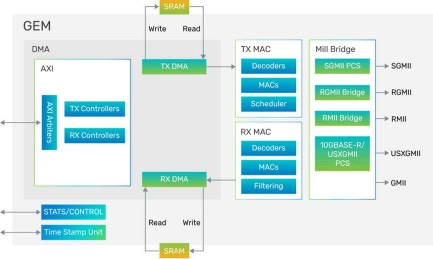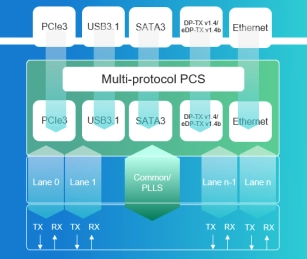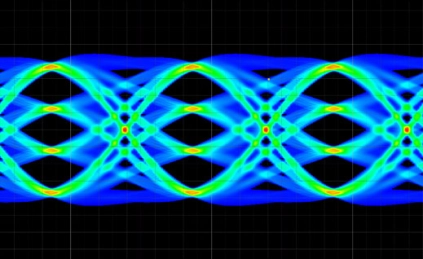Cadence SerDes IP
Filter
Compare
30
IP
from
2
vendors
(1
-
10)
-
Ethernet PCS IP - Integrates MAC IP to a broad range of PHY and SerDes IP
- Mature: Silicon-proven design in volume production at multiple customers
- Ease-of-use: Customizable with easy integration
- Designed by an Industry Leader: Cadence is an active contributor to the IEEE 802.3 standards working groups

-
112G-ULR PAM4 SerDes PHY
- Supports full-duplex 1.25Gbps to 112.5Gbps data rates
- Superior bit error rate (BER) performance across high-loss and reflective channels
- Compliant with IEEE 802.3ck and OIF standard electrical specifications
- Supports flexible SoC floorplan and IP placement and provides package substrate guideline/reference designs
-
56G-LR Pam4 SerDes PHY
- Supports Ethernet, FC, CPRI, and eCPRI protocols
- Compliant to IEEE 802.3ck and OIF standard electrical specifications
- Supports 56Gbps PAM4 and 28G, 10G, and sub-10Gbps NRZ data rates
- Unique firmware-controlled adaptive power design provides optimal power and performance tradeoffs and more efficient system designs based on platform requirements
- Continuous calibration and adaption provide robust performance across process, voltage, and temperature
- Supports industrial temperature range -40°C – 125°C
-
112G-ELR PAM4 SerDes PHY - TSMC 5nm
- TSMC 5nm FinFET CMOS Process
- Power-optimized for ELR and LR links
- Integrated BIST capable of producing and checking PRBS
- 56-112Gbps PAM4 or 1-56Gbps NRZ data rates
-
PCIe 4/3/2 SerDes PHY - GLOBALFOUNDRIES 22nm
- Duplex lane configurations of x2, x4, and x35
- Transmit swing of at least 800mV differential peak-to-peak for MR & LR, 360mv for SR
- Support for AC-coupled interfaces
- Fine-grain power up/down capability for power optimization, and ability to turn off unused link(s)
-
28G LR Multi-Protocol SerDes (MPS) PHY - Samsung 14nm
- Optimized for low-power operation and north/south die-edge placement
- Duplex Lane configurations of x4 and x1
-
28G LR Multi-Protocol SerDes (MPS) PHY - GLOBALFOUNDRIES 12nm
- Optimized for low-power operation and north/south die-edge placement
- Duplex Lane configurations of x4 and x1
-
32G LR Multi-Protocol SerDes (MPS) PHY - GLOBALFOUNDRIES 22nm
- Supports data rates of 2.5 to 32 Gbps
- Optimized for low-power operation and north/south die-edge placement
- AC-coupled RX front end with on-chip capacitors
- Flexible ASIC interface for sharing impedance codes among multiple PMA hard macros and reducing the number of external reference resistors for impedance calibration
-
Ethernet SerDes - 16Gbps and 10Gbps multi-protocol SerDes PHY
- Wide range of protocols that support networking, HPC, and applications
- Low-latency, long-reach, and low-power modes
- Multi-Link PHY—mix protocols within the same macro
- EyeSurf —non-destructive on-chip oscilloscope
- Extensive set of isolation, test modes, and loop-backs including APB and JTAG
- Supports 16-bit, 20-bit, and 32-bit PIPE and non-PIPE interfaces
- Selectable serial pin polarity reversal for both transmit and receive paths

-
224G SerDes PHY and controller for UALink for AI systems
- UALink, the standard for AI accelerator interconnects, facilitates this scalability by providing low-latency, high-bandwidth communication.
- As a member of the UALink Consortium, Cadence offers verified UALink IP subsystems, including controllers and silicon-proven PHYs, optimized for robust performance in both short and long-reach applications and delivering industry-leading power, performance, and area (PPA).
